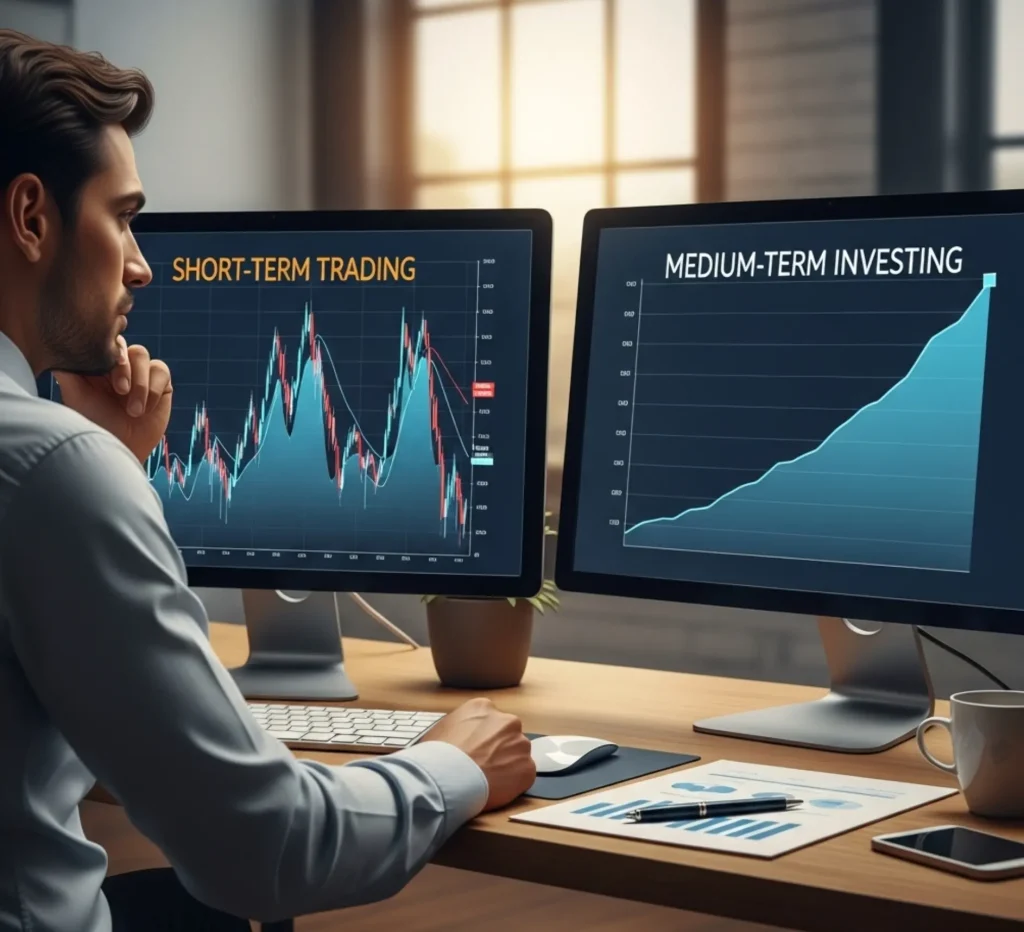Many investors try to play the short-term game, but very few actually win.
Over time, I’ve shifted my investment approach to focus less on daily market swings and more on capturing medium-term trends that last several weeks or months. This strategy not only reduces stress but also helps build a stronger foundation for long-term financial success.
In this article, I’ll explain:
- Why short-term trading is so challenging
- Why medium-term investing makes more sense for most people
- How emerging technologies like artificial intelligence (AI) and blockchain could create a golden era of wealth for those positioned on the right side of history.
The Shift From Short-Term to Medium-Term Investing
In the early days of my investment journey, I often focused on short-term trades. Sometimes holding positions for just a few days. This was especially true in the world of cryptocurrencies, where volatility can be extreme.
But over the years, I realized that consistently predicting short-term market moves is nearly impossible. Prices fluctuate due to countless factors, from news headlines to social media chatter, and the competition in this space has become fierce.
Today, my average holding period has changed significantly:
- U.S. equities (stocks): about four months
- Cryptocurrencies: from just a few days to now several weeks
This shift reflects a deeper understanding: the real opportunities lie in capturing larger market moves that play out over time.
Why Short-Term Trading Is a Losing Game
Let’s face it: short-term trading looks attractive in theory. Who wouldn’t want to buy low in the morning and sell high by the afternoon? But in reality, it’s a game stacked against almost everyone.
Here’s why:
- Markets are highly efficient. With technology and instant access to information, prices adjust quickly to new data. By the time most retail investors react, the opportunity is gone.
- Hedge funds use advanced AI. Firms like Renaissance Technologies, founded by Jim Simons, employ teams of PhDs and machine learning algorithms to exploit tiny market inefficiencies. Competing with them is like trying to outrun a Formula 1 car with a bicycle.
- Emotional noise distorts decisions. Social media spreads news (and rumors) at lightning speed. This fuels fear and greed, pushing prices in unpredictable ways. Trying to navigate these daily waves often leads to losses.
For 99.9% of people, short-term trading is a battle not worth fighting.
The Power of Medium- to Long-Term Investing
While short-term trading has become tougher, the long-term game hasn’t changed. Great companies and strong assets still create value over time, regardless of daily volatility.
Think of Amazon, Apple, or Tesla. Their stock prices went through ups and downs, sometimes even sharp declines. Yet, investors who held on for years saw massive returns because these companies continued to innovate, expand, and capture markets.
The same principle applies to cryptocurrencies like Bitcoin and Ethereum. Despite extreme fluctuations, both assets have shown significant growth for long-term holders.
By focusing on medium-term trades, riding the major upward moves that last several weeks or months, investors can:
- Avoid the stress of constant monitoring
- Capture meaningful gains without excessive trading
- Stay aligned with long-term wealth-building goals

A New Era of Opportunities: AI, Robotics, Blockchain, and Beyond
We are standing at the edge of a technological revolution. Artificial intelligence, robotics, blockchain, and even space exploration are transforming industries at a rapid pace.
Here’s why this matters for investors:
- AI is accelerating efficiency. From healthcare to finance, AI is optimizing processes and creating entirely new business models.
- Robotics is reshaping industries. Automation is revolutionizing manufacturing, logistics, and even personal services.
- Blockchain enables trust without intermediaries. Cryptocurrencies and decentralized applications are redefining finance and digital ownership.
- Space exploration opens new frontiers. Companies like SpaceX are reducing costs and unlocking opportunities beyond Earth.
These innovations benefit from a “winner-takes-most” dynamic. In other words, a few leaders in each field are likely to capture the majority of the value created.
That’s why identifying and holding these winners in your portfolio could be one of the smartest investment decisions for the coming decade.
Why Being on the Right Side of Change Matters
History shows that wealth tends to concentrate in breakthrough innovations. The industrial revolution, the internet boom, and now the rise of AI all created massive winners for early investors.
The challenge (and opportunity) lies in positioning yourself before these trends become obvious to everyone.
By focusing on assets with strong fundamentals and long-term potential, you’re not just betting on the next price move. You’re aligning yourself with the transformative forces shaping our future.
Related Reading
To sharpen your edge, explore:
Connecting the Dots: The Skill That Separates Ordinary Investors from Visionaries: how to synthesize data, narratives, and price action into actionable insight)
New Trends and Technologies: How to Seize Opportunities That Can Change Your Life: a practical playbook for spotting real adoption vs. hype and building sensible entry plans)
Adaptability Has Always Been Key. In an AI-Driven World, It Becomes Essential: why flexible rules, faster feedback loops, and continuous learning now matter more than ever
Final Thoughts: Are You Ready for This Revolution?
Short-term trading might look tempting, but for most people, it’s a costly distraction. Instead, focusing on medium-term opportunities aligned with long-term growth provides a smarter, more sustainable path to wealth.
We are entering a golden era driven by AI, robotics, blockchain, and space exploration. Some companies and digital assets will become the undisputed winners, creating and capturing most of the new wealth.
Disclaimer: This article is for informational and educational purposes only. It does not constitute financial, investment, or legal advice, and should not be taken as a recommendation to buy, sell, or hold any asset. Always conduct your own research and consult with a qualified professional before making any financial decisions. The author and publisher are not responsible for any actions taken based on the information provided in this content.
